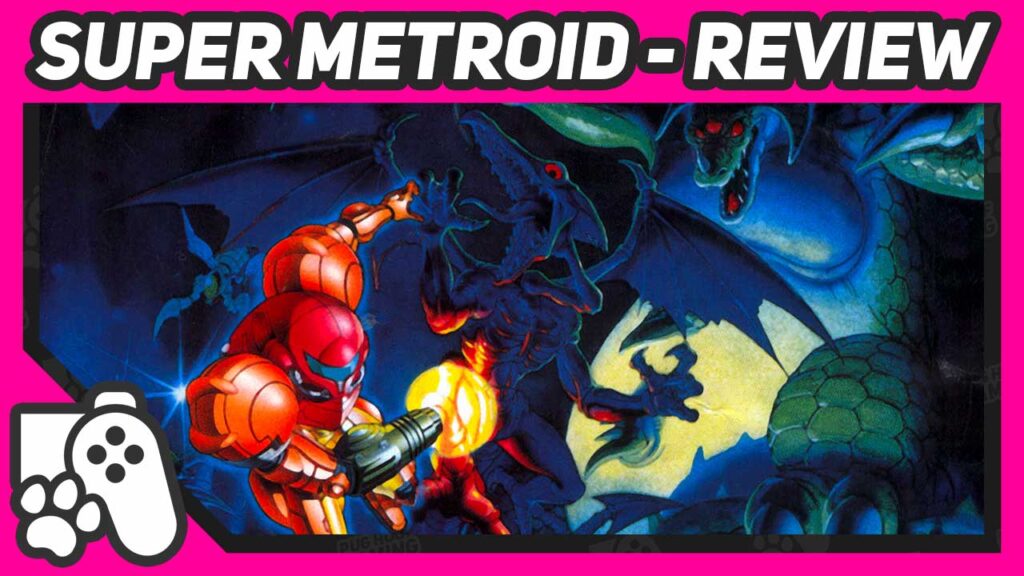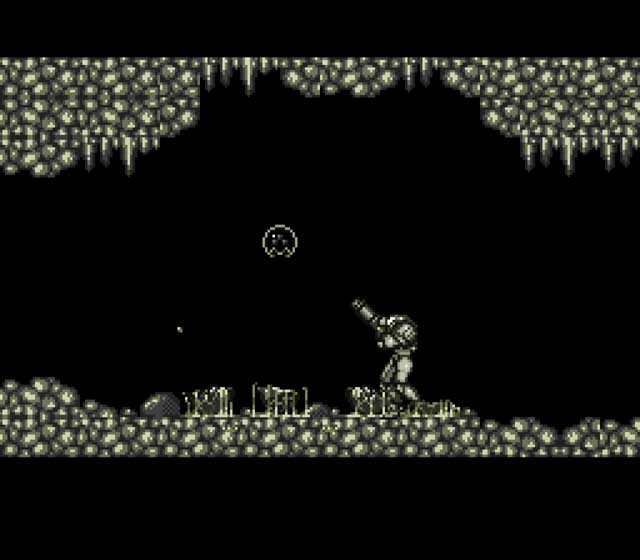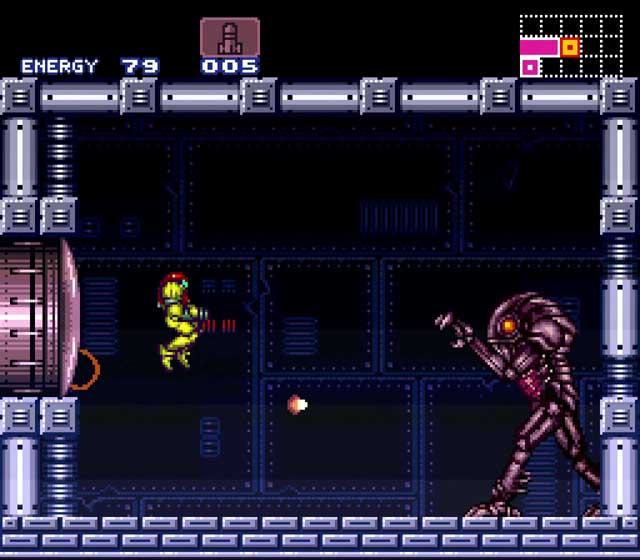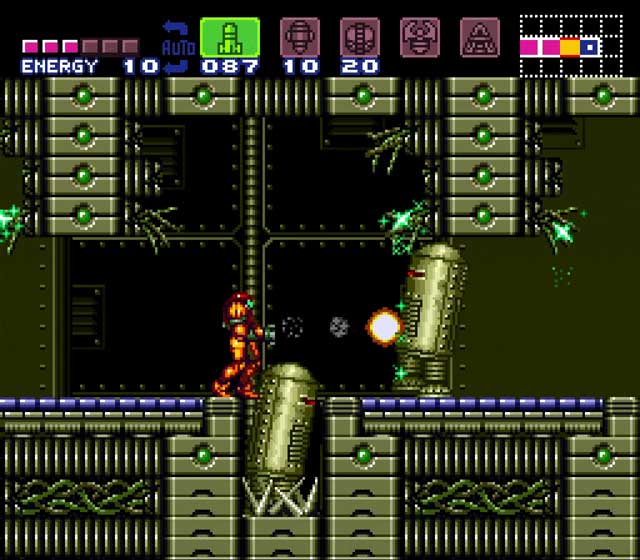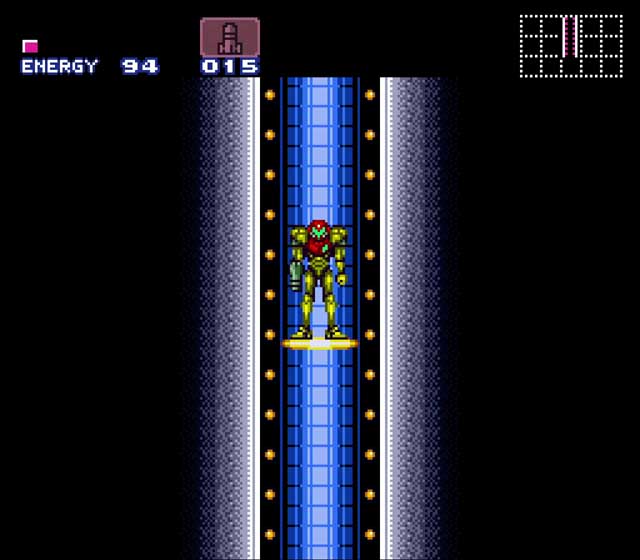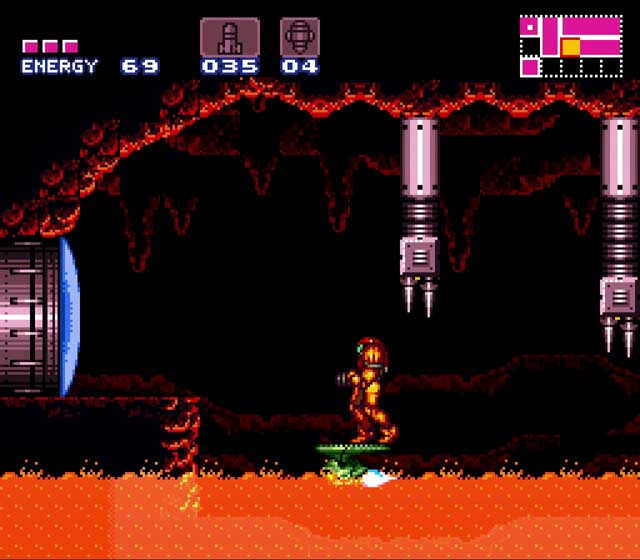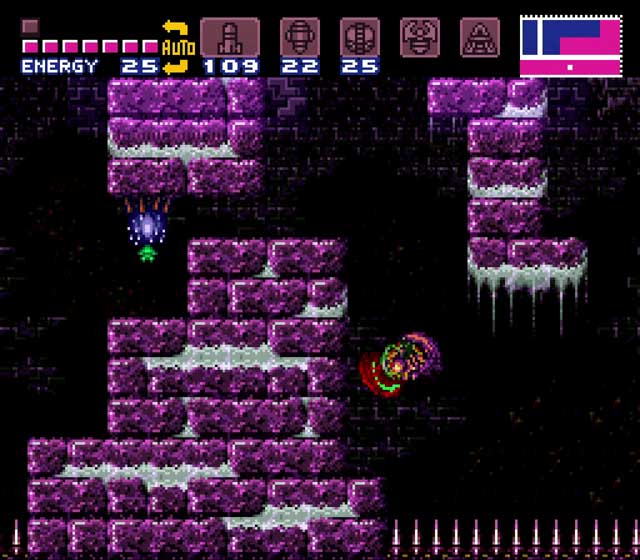“The last Metroid is in captivity. The Galaxy is at peace”. Never before has a videogame opened with such an unusual statement. After all, what is Super Metroid, the third game in the series, without its titular alien species?
Lucky for you, me and gaming history, that statement is thankfully a short-lived one. But, it hails the beginning of a game that has been critically acclaimed since its 1994 release. Look, if you came to this video wondering if Super Metroid is any good, I don’t want to waste your time – It’s great. Actually, it’s more than that, it’s one of the greatest games ever made. It’s all of those lovely threads of exploration and atmosphere from Metroids 1 and 2, woven together and improved upon to make a title that is immensely playable and compelling from start to finish. If that’s all you needed to know, that you have my permission to close this Super Metroid review and boot the game up if you haven’t done so already (or replay it if you have) – However, if you want to know why Super Metroid is so damned good, then please do stick around, because I’m going to explain that what I’ve stated so far is no hyperbole.
I don’t come to Super Metroid from a position of nostalgia. On the contrary, because of Nintendo’s rather aggressive marketing, giving the impression that the game was intimidatingly hard; I was honestly turned off at the time. In 1994, given the choice between this release and Mega Man X, I chose the latter – Not really a terrible choice as it happens, but if I had seen past the commercials and went for the former, I think I would have been happier. But, could you blame me? Here in Europe, Super Metroid came in an oversized box containing a 72-page guide to the entire game, as if to say “This title is so tough, we are literally going to tell you how to finish it”. As a result, this series passed me by until the mid-2000s, and I wouldn’t be on board until Metroid Fusion. Afterwards, it was at this point where I went back to earlier titles in the series and saw Super Metroid’s greatness. Oh, and later ended up with a more permanent reminder on my arm a few years later.
Super Metroid Review – The Story So Far
And it all started with that short intro sentence, in digitised speech, no less. This moody intro explains everything that happened in the first two games, acting as both a good reminder or a useful exposition dump, depending on your experience with the series. It really does highlight how little is going on narratively in prior Metroid games, against the level of abundance of storytelling going on in this one, and arguably this title acts as much of a reboot as it does the continuation of a story. This intro is the only dump of obvious exposition you’ll see in the entire game – The events that happen hereafter are entirely conveyed through in-game actions without a word of dialogue. But I’ll get onto that in a bit. Essentially, Metroid II ends with the discovery of a Metroid hatchling that imprints on Samus. Not being one to be tied down, our hero hands the creature into the authorities to be studied, much like the Space Pirates had done previously, only to aid the galaxy instead of enslaving it. Unfortunately, the moment our hero leaves the lab where the Metroid is being held, a distress signal is activated and the game begins.
The player is dumped into a prologue of sorts, set in a now-empty lab. There’s no sign of the Metroid hatchling, and a heap of bodies on the floor, so you can only wonder what has happened. Immediately afterwards, you stumble upon the deadly cargo, safely in its glass canister, but this short area is punctuated by your first meeting with Ridley – Samus’ nemesis. She’s gotten a lot bigger since her NES debut, but thankfully this is one of those fake boss fights where you can’t die or defeat Ridley – Either way, this deadly flying creature swoops off with the Metroid hatchling before the lab begins its self-destruct sequence, echoing the ending to the original Metroid. Here, it is absolutely possible to not make it in time and get an instant Game Over, but the timer is generous enough to make that eventuality only occur as a deliberate mistake. After returning to the ship, Samus follows Ridley to the Planet Zebes, where everything first occurred in the original game. On this planet, you’ll spend the rest of your playtime with the sole mission – Find the Metroid hatchling.
From here on, the player can explore this dangerous planet as they please, although within the limitations set by environmental hazards and physical barriers that require abilities gradually found through exploration. You’ve seen this gameplay loop before in the two prior games, but it’s never been done as elegantly as it has here. As a player, you feel empowered by the freedom you believe you have, but you never realise that the developers are using clever tricks to guide you through a mostly linear path. The feeling of being overwhelmed is a thing of the past, thanks to the addition of a brand new map function. This incredibly welcome feature not only tracks where Samus has been but also shows selected areas that haven’t been visited by finding Map Stations. Plus, the majority of items, upgrades and other items of interest are also displayed with a simple dot. Unfortunately, it doesn’t point out what items have been found, but the mere presence of this feature fixes the biggest issue with the series so far. This map does well to tread the fine balance of helping the player out, without giving them all of the information – It’s still down to you to explore, but at least you now know where you’ve been, where you are and have a rough idea of where you’re going.
The way the developers guide you through the entire game is nothing short of masterful. There is no sniff of a tutorial anywhere in the game, but a whole heap of gentle pushes and environmental storytelling that meticulously tell the player what to do, provided they are willing to observe the world around them and pay attention to these lessons. Find a fork in the road, and no matter what way you go, you’ll learn something – The location of a new item or upgrade, or a barrier to make a note of and return later once more upgrades have been found.
There is an argument to be made that Super Metroid is a game with no story. But that’s an argument made by people that aren’t paying attention. Yes, there is no explicit narrative thread – That is true. However, Super Metroid is still a masterclass in conveying narrative – How so? The devil is in the details – That introductory monologue by Samus is enough to give the player a grounding in what got her to this point; her motivations and what her mission is. After this point, the player is dropped into immediate gameplay and knows about as much as Samus does. Provided the player pays attention, the clues are there to what’s going on with the Space Pirates and their intentions for the Metroid hatchling (including the now infamous ending). All narrative information is expertly delivered without a single written or spoken word of dialogue.
There’s no better example of Super Metroid’s approach to showing the player instead of telling them, than a few special moves that Samus can employ that aren’t even revealed in the manual. Eventually, the player will run into the rarest of all things on Zebes, friendly creatures. The first species you meet are three monkey-like Etecoons, that demonstrate the tricky-to-master wall jump, while later on when armed with the Speed Booster upgrade, you meet an ostrich-like creature called a Dachora, who demonstrates the incredibly useful Shinespark manoeuvre, used to shoot up into the air with great velocity. And let’s not ignore the huge amount of info that can be gleaned from the game’s demonstration sequence if you let the title screen linger. Not only does it give you a very good idea of what to expect throughout Super Metroid’s playtime, but it also shows off an array of super-hidden moves that, if you pay close attention, you can replicate yourself – From a few screen-clearing attacks using a combination of charged beams and Power Bombs, from the energy-healing Crystal Flash move. It’s been said that Super Metroid is a game that can be replayed over and over again, and every time you’ll notice something new, and this really is no exaggeration.
It’s a game, absolutely full of surprises, and always ready to subvert your expectations – Especially if you’re a veteran of the prior two games and think you know how things work. Your initial steps on Zebes involve walking through the dilapidated and abandoned area of Tourian, where Mother Brain was fought and defeated before visiting the starting area from the original NES Metroid to pick up the Morph Ball, exactly where it used to be – Picking it up triggers a weird sensor, which you think nothing of. When you walk back through Tourian, you’re shocked to find the area is now filled with Space Pirates, who are alerted to your presence on their planet. Your next pickup is the Morph Ball bomb, an always-useful tool in Samus’s arsenal. No biggie, you tell yourself, as you soon find it clutched in the hands of a Chozo statue. It’s there, waiting for you to pick it up, in a place that’s usually a haven of safety. But once the new item is picked up, the doors are locked, the statue springs to life and attacks you – It’s the thing you least expect if you’ve played the prior games.
Discovery is a constant theme throughout Super Metroid. There’s always something new to be found, learnt or be afraid of, and no matter how far off the beaten track you wander, you never feel like time is being wasted. Everything you do is always for the greater good of improving Samus’s chance of survival on Zebes. And with finding so many new weapons, suit upgrades and mobility enhancements, you’ll be pleased to know that the pause menu lets you see everything you have – Plus, these upgrades can be toggled on or off as you please. No longer will you have to physically go to the original locations of the Ice Beam and Wave Beam to switch between the two, because now you can turn them off, on and as all weapons stack, mix the different types of beam together to create new ones.
And outside of offensive weaponry, the more utilitarian upgrades in Super Metroid are also pretty awesome. The Grappling Beam is a cool item that is used to swing from certain blocks but can even be used to defeat a certain boss if used in a more incorrect (and painful) fashion. However, this upgrade is more or less surplus to requirements once the Space Jump and Screw Attack upgrades are found, which still allow Samus to remain in the air indefinitely by timing somersault jumps, but are still quite tricky to get the timing down. Once you do though, it’s rather satisfying. The X-Ray scanner is also a really useful item for exploration – Once obtained, no longer do you have to spend ages shooting and bombing blocks to see if there are any hidden passages or items – Just use this scanner and you can see exactly where all those secrets are, and what you need to open them up. As well as Energy Tanks, you can now obtain Reserve Tanks which can be stored with excess energy pickups and can be used to heal you up automatically when your main energy runs out or it can be manually activated as needed.
Super Metroid truly feels like a refinement from everything that came before. The controls feel spot on – No longer are the diagonal jumps ridiculously fiddly as they were in the original game. While Samus does feel unique to control, with a good sense of the weight of her Power Suit, you do feel like there’s a bit more precision in her movement, which is perfect as there’s still plenty of platforming to be done around the shooting and exploring. The action is exciting without being overwhelming. There is a challenge without the game feeling impossible to beat. And most importantly, every item or upgrade you find makes you feel powerful without feeling too invincible. There’s always a bigger bad out there.
Of course, that sense of dread you feel can be somewhat blamed on the audio. While Metroid and Return of Samus had some semblance of a soundtrack but relied more on moody ambience, Super Metroid is a bit more consistent with its approach to backing audio. It’s certainly a more listenable soundtrack as a whole, but not at the cost of scene-setting and ambience that the series is known for. The game really covers a spread of tempos and feels with its music – Going from the chilling synth moodiness of the Wrecked Ship theme, to Brinstar’s prickly, electro-funk backing. These tracks have been covered so many times over the past few decades through a variety of genres, which tells you exactly how striking these pieces of music are. A considerable amount of these tracks were also reused and remixed for later Metroid games, including the Prime trilogy, providing further proof of this soundtrack’s excellence.
Visually, Super Metroid is certainly distinctive, and like prior games – Very non-Nintendo-like. Samus’s sprite is a more refined version of her appearance in Return of Samus, her Power Suit looking a bit bulkier and fleshed out, with its animation giving a further hint about the strength Samus needs to move in this hulking metal suit. Enemy sprites are recognisable for returning enemies, while the weedy sprites for Kraid and Ridley have been transformed into exponentially more threatening forms this time around. As for the environments, Zebes is home to a much more varied range of environments this time around, and they all look great. There’s much more going on in the background, while foreground elements are much more detailed. It’s all about the little details too, such as the refraction effects while in the underwater region of Maridia, or the heat hazing in the background of Ridley’s Lower Norfair hideout. Even the underside of blocks in lava-filled rooms look like they’re reflecting the light of the hot magma below.
All of these tiny details, finely pruned elements from prior titles, and countless new approaches to gameplay loops, player guidance and progression, all come together to create one of the greatest games ever released. If a criticism could be made, while the new map system is a welcome addition, the lack of ability to keep track of what pickups have been found is a little frustrating and can lead to many wasted hours of backtracking with a map to find everything that’s been missed. Also, depending on the type of player you are, you may feel a little frustrated with the lack of overt information on how to progress – Many a player has found themselves stalling on the infamous “Noob Bridge”, without the knowledge that they need to use the run button to speed past the crumbling blocks. For as great as Super Metroid’s “show, not tell” approach is – I wouldn’t begrudge any player who finds it a little frustrating in today’s age of tutorial-led gaming.
However, if you are able to have the patience to observe everything the developers are trying to show you, you’ll struggle to find a game that will continue to show you something new, no matter how many times you play, trying to finish the game with as many items as possible while going for the quickest times you can. Just watch a few videos of experts speedrunning the game and you’ll see what’s possible. But even if you’re going at your own pace, you’ll have plenty of time to take in every masterstroke of a truly incredible game.
It says a lot that even the team behind Super Metroid didn’t have the confidence to create a follow up for the Nintendo 64 console. But after a drought that lasted many years, fans of the series were given plenty of cause for celebration. Next up on the Road To Metroid Dread, is a look at Metroid 4 – Or as we know it, Metroid Fusion. Come back very soon and check out my review of this handheld sequel.
